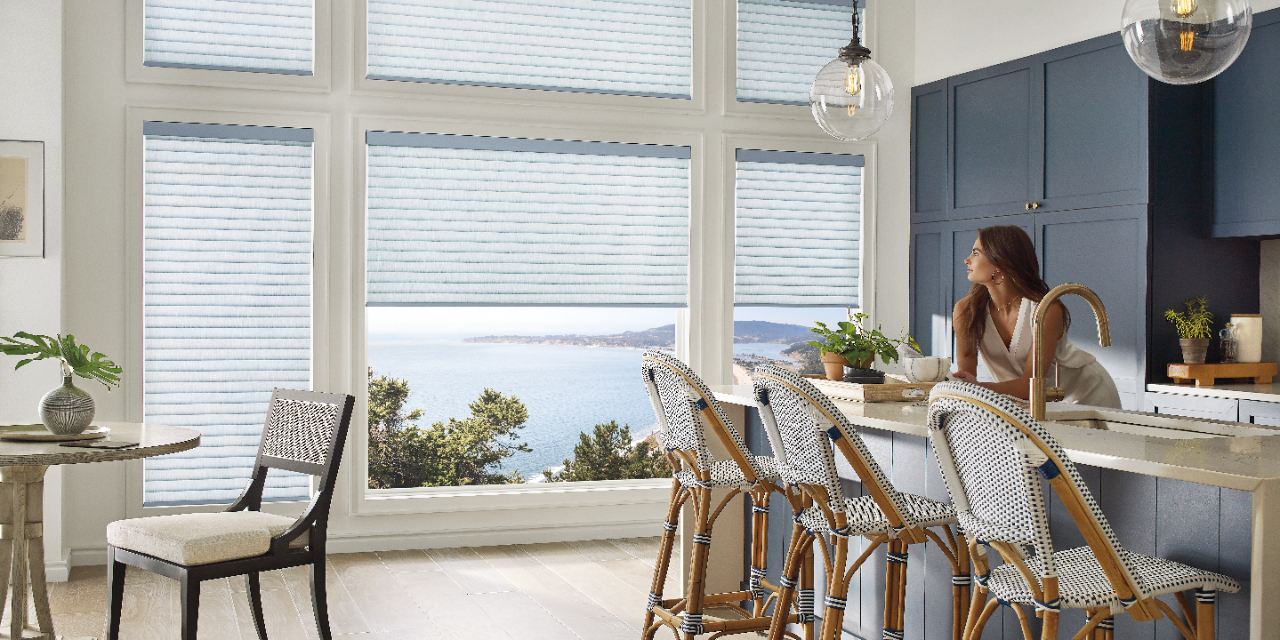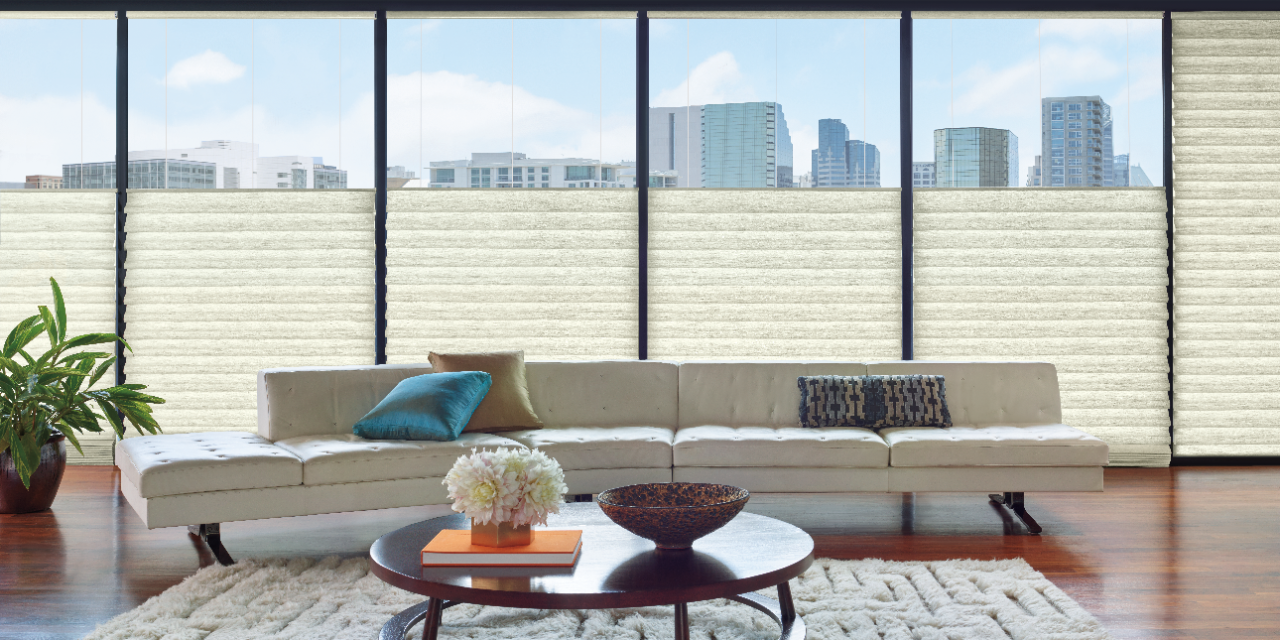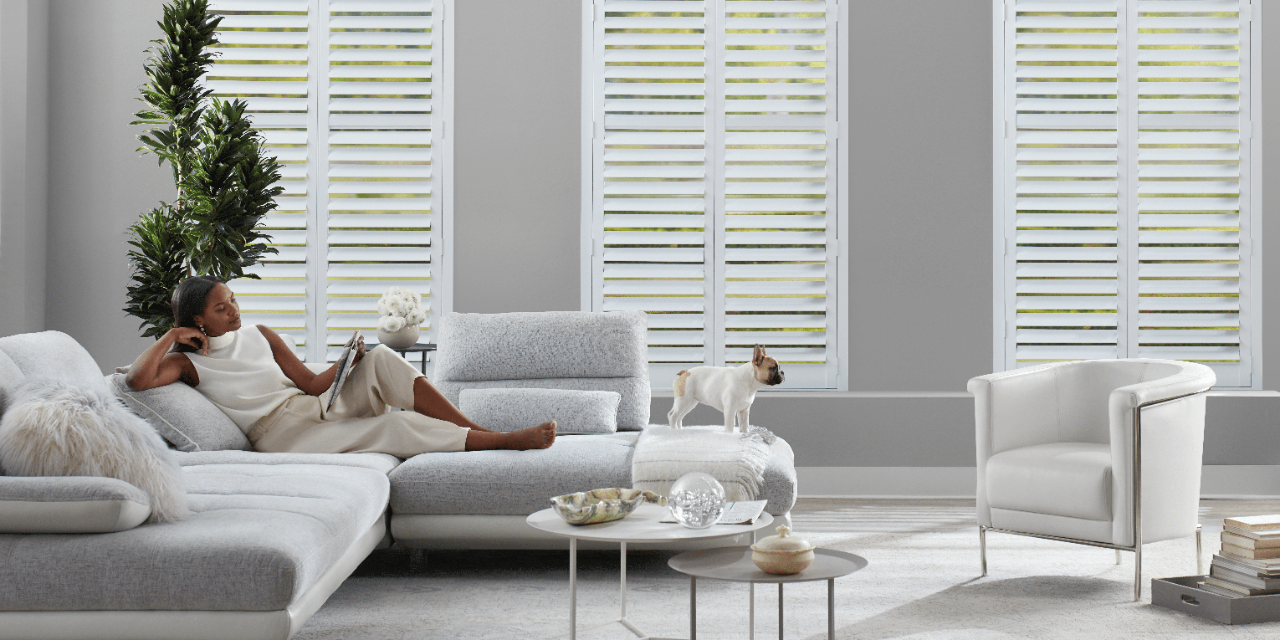-
- Motorization
- Aura Illuminated Shades
- Browse by Need
-
Shades
- Crafted from a continuous piece of fabric.
- Aura Illuminated Shades
- Sheer Shades
- Roller Shades
- Cellular Shades
- Roman Shades
- Woven Shades
- Vertical Shades
- View All Shades
-
Blinds
- Crafted with separate and distinct slats or panels.
- Wood Blinds
- Metal Blinds
- Vertical Blinds
- View All Blinds
- Shutters
- Drapery
- Commercial Solutions
-
Customer Support
Articles
Energy Efficient Blinds and Shades
Creating Your Comfort Zone
Creating Your Comfort Zone
Window treatments can go a long way toward boosting your home’s energy efficiency, keeping you comfortable. That’s because compared to insulated walls and ceilings, windows easily allow more heat to escape from a room in winter and more heat to enter a room in summer.
In fact, without energy-efficient window coverings, a home can lose up to 30% of heating and cooling energy through its windows, according to the Department of Energy.
How Window Treatments Improve Energy Efficiency
Window treatments help with a home’s energy efficiency by providing insulation, controlling solar heat gain, and by using natural light to reduce the use of electric light (called daylighting), which saves energy. Here’s a look at each—and how they help create your comfort zone.
Providing Insulation—Winter/Cool Climates
In winter, or if you live in a cool climate, window treatments help insulate at the window, preventing heat from escaping and keeping a room warmer.
Open your window treatments during the day so that free solar heat from direct sunlight will warm your home.
On cloudy winter days, close your window treatments to add an insulating layer to your house that will keep warm air in.
At night, close your window treatments to add that insulating layer.
Controlling Solar Heat Gain—Summer/Warm Climates
During the day, close your window treatments to prevent the sun’s harsh rays from heating up a room, keeping it cooler (so your A/C doesn’t have to work as hard).
At night, keep your window treatments closed to keep the cool air in.
Using Daylighting
Natural light illuminating a room can make it more inviting, and may even boost your mood at the same time. You can maximize natural light with window treatments that draw it into a room, reducing the need for electric light, which reduces energy use.
Earn A Federal Tax Credit up to $1,200!
Save energy year-round—and earn a Federal Tax Credit of up to $1,200 on select energy-efficient shade styles
Tax Credit Qualifying Products
To be eligible for the tax credit, purchase and have your qualifying products installed between January 1 and December 31 of the applicable tax year.
For a list of qualifying products, please see the Qualifying Product Document below. For more information see our Frequently Asked Questions.
Energy Efficiency A-List
Energy Efficiency A-List
The Attachments Energy Rating Council (AERC) is an independent organization, partially funded by the U.S. Department of Energy, whose mission is to provide consumers with reliable information about the energy performance of window attachments (blinds, cellular shades, roller and solar shades).
Hunter Douglas is the first company to receive an AERC certification for interior window coverings. Currently, Duette® and Applause® Honeycomb Shades, Vignette® Modern Roman Shades, Sonnette® Cellular Roller Shades and select Designer Screen Shades are AERC certified. Visit our AERC page to learn more.
And on the AERC website, you can search for AERC certified products and compare window attachment ratings in categories such as Cool and Warm Climate Ratings.
Leading Energy-Efficient Window Treatment Styles
When it comes to window treatments, energy efficiency and comfort go hand in hand. And while all Hunter Douglas window treatments help you live more comfortably, the following are the best options when it comes to enhancing energy efficiency.
Cellular Shades
Cellular shades are the most insulating interior shades available anywhere. While you might think your vinyl blinds are helping save energy, field studies have shown that cellular shades outperform traditional vinyl blinds in terms of energy efficiency.
- Duette Architella® Honeycomb Shades—This style is the most energy-efficient cellular shade available, providing even greater insulation than the original Duette. That’s because its honeycomb-within-a-honeycomb construction has more layers of fabric and insulating pockets than other fabrics in the Duette line.
- Duette® Honeycomb Shades—The original cellular shade, featuring a unique honeycomb construction that traps air in distinct pockets, for an extra layer of insulation at the window. Available for every window shape, including skylights and European-style tilt and turn windows, as well as French and sliding doors.

Roller and Solar Shades
Roller and solar shades feature clean, contemporary lines, and help reduce heat gain in a room; solar shades also filter sunlight.
- Sonnette® Cellular Roller Shades—These modern cellular shades combine the insulating construction of a cellular shade with the clean lines and simplicity of a roller shade.
- Designer Screen Shades—Designed to provide UV protection while reducing glare and heat gain in a room, Designer Screen Shades are available in a range of openness factors so you can select the view and level of light you want.

Roman Shades
Roman shades provide the benefits of a cellular shade but with the luxurious look of a Roman shade.
- Vignette® Modern Roman Shades—Vignette features exquisite woven fabrics, flat or contoured folds, and doesn’t have exposed cords on the back of the shade.
- Vignette Duolite®—This style combines a light-filtering or sheer front shade with a room-darkening back panel; once the front shade is completely lowered you can adjust the back panel for varying levels of light control (and privacy). The room-darkening liner provides additional energy efficiency to already energy-efficient, beautifully woven Vignette fabrics.
Side Panels and Drapery
Side panels and drapery add another layer of insulation at the window, while helping to prevent light gaps.
- Carole Fabrics™ Drapery and Side Panels—Designed to complement any aesthetic, these beautiful, distinctive fabrics are perfect alone or layered.

Shutters
Interior shutters—whether wood or vinyl—add character to a room, while the natural insulating properties of wood and the air barrier inside vinyl shutters help create a more comfortable space.
In winter, open shutter louvers so the sun’s rays can help warm up interiors—or close them to keep cold air out. In summer, close louvers to help keep warm air and the sun’s rays out, so a room stays cooler, reducing air conditioning costs.
- NewStyle® Hybrid Shutters—Durable and beautiful, these hybrid shutters are great for high-traffic areas, and are available in a variety of colors and design styles.
- Palm Beach™ Polysatin™ Shutters—Because these shutters are made to take the heat, they’re ideal for windows exposed to sunlight and moisture, and are an excellent choice for damp or humid spaces. Made from a durable polysatin compound, Palm Beach shutters won’t warp, crack, fade, chip or peel.
- Heritance® Hardwood Shutters—Elegantly crafted from 100% natural basswood or poplar hardwood, Heritance shutters add a richness to any room. Choose from a wide selection of paints and stains as well as custom colors.
Adding Smarts To Your Shades, Drapery And Shutters
Adding Smarts To Your Shades, Drapery And Shutters

To capitalize on the energy efficiency you get from shades, you need to raise and lower them as necessary, depending on the time of day and time of year. But what if you’re not home, or simply busy?
That’s where motorized shades (as well as automated drapery or shutters) can help.
Automated window treatments add convenience to your day to day, while making it easier to save energy. With PowerView® Automation, you can schedule your window treatments to move according to schedules you set. That way, they’ll be in the best positions to block heat loss when it’s cold or keep out harsh rays in the summer. And if you integrate your PowerView Hub with a compatible smart-home system, you can program your window treatments to adjust in response to light- and temperature-sensor commands sent from that system.
For instance, when your home reaches a certain temperature, you can set your shades to automatically lower, blocking light from entering the room. This provides better insulation, blocks solar heat gain and also prevents the sun from fading and deteriorating your fabrics, carpet, hardwood floors and other wood surfaces.
Energy Efficient FAQs
Based on our AERC rated and certified products, Hunter Douglas room-darkening Sonnette® Cellular Roller Shades, room-darkening Duette® Architella® Honeycomb Shades and select Designer Screen Shades are the best- performing window treatments for keeping your home cooler when temps rise and warmer when they dip.
Learn more about insulating shades.
Our Duette Architella Honeycomb Shades are available with the Vertiglide® system, which is designed for vertical applications like sliding-glass doors. Vertiglide uses the same fabrics as all of our cellular shades, providing an additional layer of insulation at the door or window.
Fabric opacity—the amount of light that passes through a fabric—does play a part in energy efficiency. Based on AERC energy ratings, room-darkening fabrics, as opposed to sheer, semi-sheer and light-filtering fabrics, help keep rooms warmer in the winter and cooler in the summer.
Based on AERC energy ratings, pleat size can make a marginal difference in energy efficiency. So when deciding on a cellular shade, base your choice on the pleat size and color that will best complement your room.
Yes, multiple layers of cellular fabric do make a difference. That’s because multiple fabric layers allow for additional air pockets in cellular shades, and air pockets are what gives these shades their insulating properties.
AERC rated and certified products are based on an inside mount. When determining energy efficiency, an inside-mounted window treatment has less variables to take into account, such as overlap over molding, window hardware and frame distance from shade to wall, than does an outside-mounted window treatment.
Energy Efficienty News & Updates
Learn about the latest on energy efficiency and Hunter Douglas products.
Save Time & Effort
Meet With An Expert
We can connect you with a window-treatment expert in your area. No obligation.